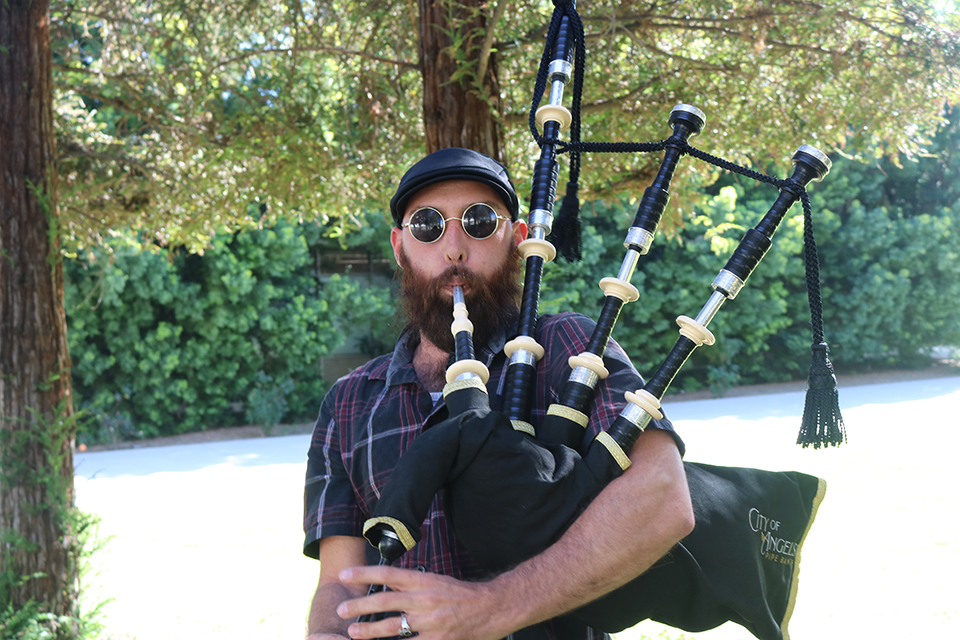Veteran, Student, Bagpiper: One CSUN’s Student’s Musical Journey
While walking the CSUN campus, students may hear any number of things. The birds in the trees, the sounds of construction or other students socializing in between classes. On some days, they might even hear the distinctive sound of bagpipes, courtesy of first-year transfer student Miles Sweet.
A Valley native, Sweet is a 28-year-old former Marine majoring in ecology and evolutionary biology. But music is a major part of his life and he carves out any time he can to practice. Since childhood, Sweet has been surrounded by music. His father was a drummer, his mother was a violinist, his grandmother played the accordion, his brother played the French horn and his aunt is a singer. Sweet said he plays about 18 instruments, including the bagpipes.
“Music has always been the reason I’m alive,” he said. “I’ve always enjoyed the practice of music. It’s kind of like meditation for me. It helps take the edge off of some of the stress and anxiety of life.”
According to Sweet, he started with classical flute when he was just 3 or 4 years old. He was introduced to the bagpipes as a teen by his music teacher, Al Nelson, at Granada Hills Charter High School. Sweet loved the challenge the bagpipes offered, and he thought they were “just really cool,” he said. He was surprised by the subtleties — and demands — of the instrument.
“With a flute, you can change the tuning twice because a flute has three parts to it,” Sweet said. “It has a head joint, a body and a foot joint. And if you pull out or push in on the foot and the head, it’ll make it sharper or flatter. Depending if you’re pulling out or pushing in with a bagpipe, there are like 60 different things you can move like 1 millimeter and suddenly, your tuning is different. So, the amount of nuance on the instrument, I think, was the biggest surprise when I was learning it.”
Sweet plays in a competitive bagpipe ensemble, the City of Angels Pipe Band. The group’s uniform features a purple-and-yellow kilt, which “feels very L.A.” with its Los Angeles Lakers color scheme, he said. Sweet always wears a kilt when he performs with his bagpipes. The kilt holds cultural significance, with each pattern and color imbued with meaning, he noted. Traditionally, the Scottish would pick and choose colors and patterns that represented their house or clan. Sweet also notes that kilt patterns have names. Of Irish descent, Sweet has his own family clan kilt that he wears for other occasions. It is called “Irish National. The Pipe Band’s kilt is “Wild Heather.”
Beyond gigs and performances with the ensemble, Sweet is a musician-for-hire as well as an audiobook narrator.
“I do a lot of weddings, and I do a few funerals on the bagpipes,” he said. “I also do a lot of parties on the saxophone and the flute. And to supplement that, I read books for a living, like audiobooks from Amazon.”
Bagpipes, he said, are not a lost art. There’s a rich and lively culture surrounding the pipes.
“From the outside looking in, you’d think, okay, there’s not a lot of people in this world that play the bagpipes,” he said. “But oddly enough, once you’re in the culture and you’re seeing all the other bagpipe players all the time, you realize you’re one small fish in a pretty big ocean.”
CSUN music professor Gigi Rabe heard Sweet practicing and couldn’t help but stop to listen — and chat.
“I was in between classes and going to the food court near the [Campus Store]. As I was walking from Cypress Hall, I heard what sounded like bagpipes,” Rabe said. “I kept walking toward the sound … that is how I met Miles Sweet.”
Rabe teaches a variety of courses in CSUN’s Mike Curb College of Arts, Media, and Communication, including “Music From a Global Perspective.” In this class, students learn music from around the world, and Rabe invites musicians to perform in class. She hopes the class makes a lasting impact on her students and how they view music as it relates to the world, she said. After getting to know Sweet, she invited him to play for her class — although the instrument’s volume necessitated the students head outside for his performance.
Sweet can often be seen practicing on campus, mainly in CSUN’s Orange Grove, but he occasionally plays near Sierra Hall as well. The campus has good acoustics, he noted, but it’s also convenient for the busy student.
“I love practicing out in nature. It’s my favorite place,” Sweet said. “I try to avoid practice rooms and being inside. If I’m playing the whole set of bagpipes, I like to go to any outdoor place I can find. There are a couple of trails and peaks that I like to go to. Sometimes, I’ll go to the beach or a nice park. Anywhere I can go outside.”
He’s often approached by people when he practices in public, and their reactions vary.
“If I run into a musician who finds out I play the bagpipes, they’ll ask me a lot of technical questions about things like the nomenclature or the physiology of the instrument,” Sweet said. “How it works, how it’s built, things like that. If I run into just a random passerby on the street, their general reaction is, ‘Oh, that’s so cool.’ Then you have the few that are just intent to troll everyone.”
For anyone who’s interested in trying out the bagpipes themselves, Sweet has some words of advice.
“It’s important to remember that it can be intimidating and frustrating,” he said. “Also, don’t skip the basics. The basics are absolutely everything with the pipe.”


 experience
experience